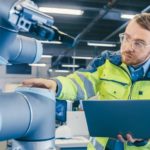 Robots are an increasing presence in the workplace, performing a growing number of roles. Recent research from the University of Michigan suggests, however, that so useful are robots becoming that we are developing emotional bonds with them.
Robots are an increasing presence in the workplace, performing a growing number of roles. Recent research from the University of Michigan suggests, however, that so useful are robots becoming that we are developing emotional bonds with them.
What’s more, the researchers suggest that these bonds can be detrimental to relationships with colleagues as we can become more attached to our robotic colleagues than our human ones.
Human-robot teams
The introduction of robots into the workplace has resulted in them becoming a key part of many work teams. The researchers highlight, however, that their presence can cause teams to fracture into subgroups that almost compete against one another rather than a coherent unit.
The research consisted of a couple of studies, the first of which was conducted in the lab, with 88 participants split into 44 teams, each of which had two robot colleagues as well as the two humans. Each participant was asked to complete a questionnaire detailing their performance as well as their relationship with their human and robot partners.
The results showed that when the human volunteers connected better with their robot colleagues, their human colleague would form a subgroup within the team, and the overall performance of the team would suffer.
The second study examined ways that this phenomenon could be negated. They recruited 112 volunteers, each of whom both worked with robots and managed other colleagues. They were quizzed on how they try and maintain good working relationships with their human colleagues when robots are also present in their teams.
This revealed that training was crucial to ensure that communication between the human members of the team improved. Leadership was also crucial in mitigating any risk of subgroups forming and undermining performances. For instance, respondents said that social activities were valuable in helping to form bonds between team members.
These helped to ensure that employees had strong connections with each other, and indeed stronger connections with their human colleagues than with their robot colleagues, which helped to ensure that teamwork quality remained high.